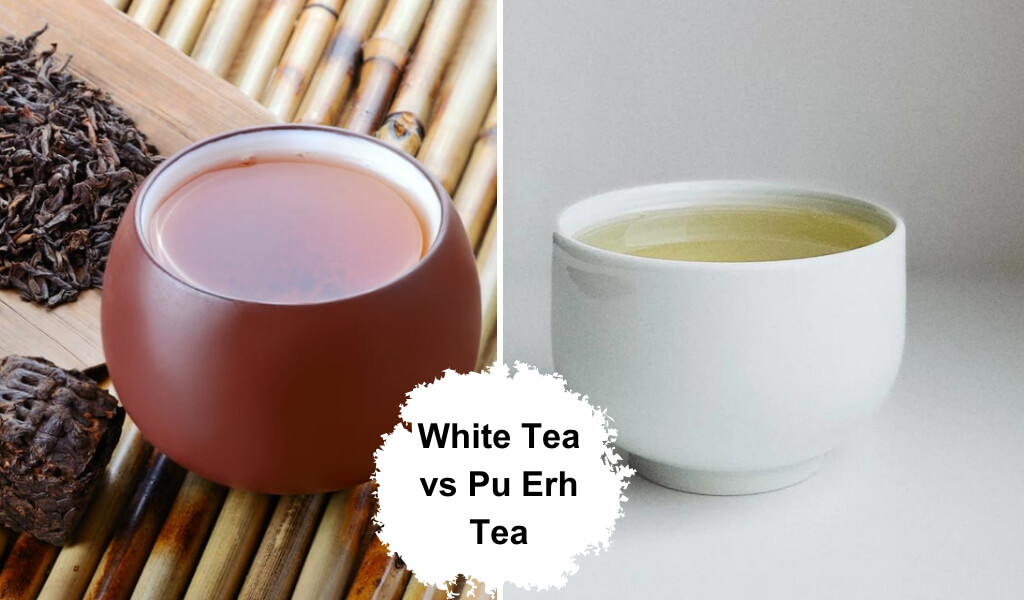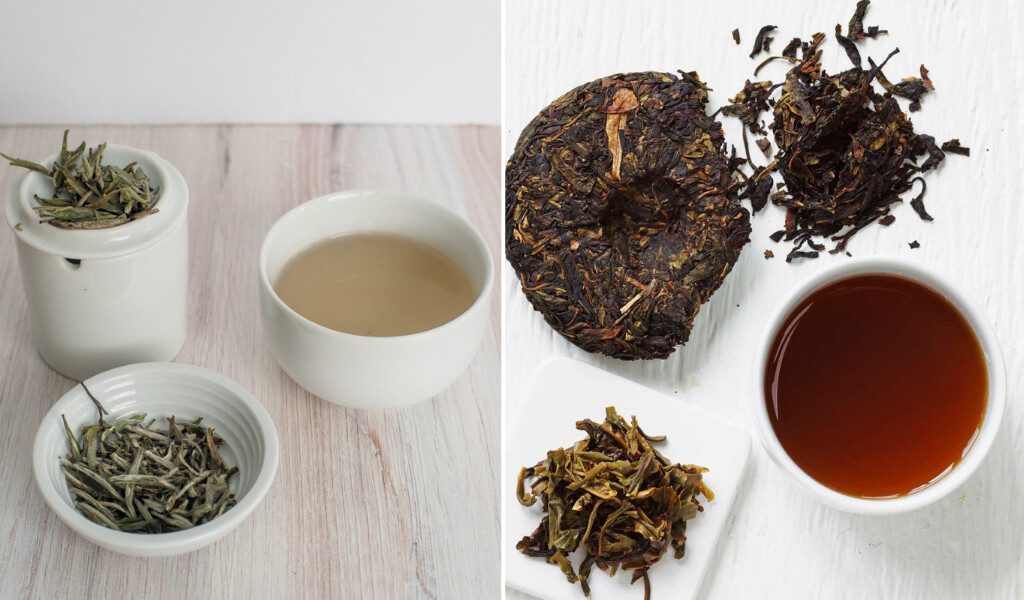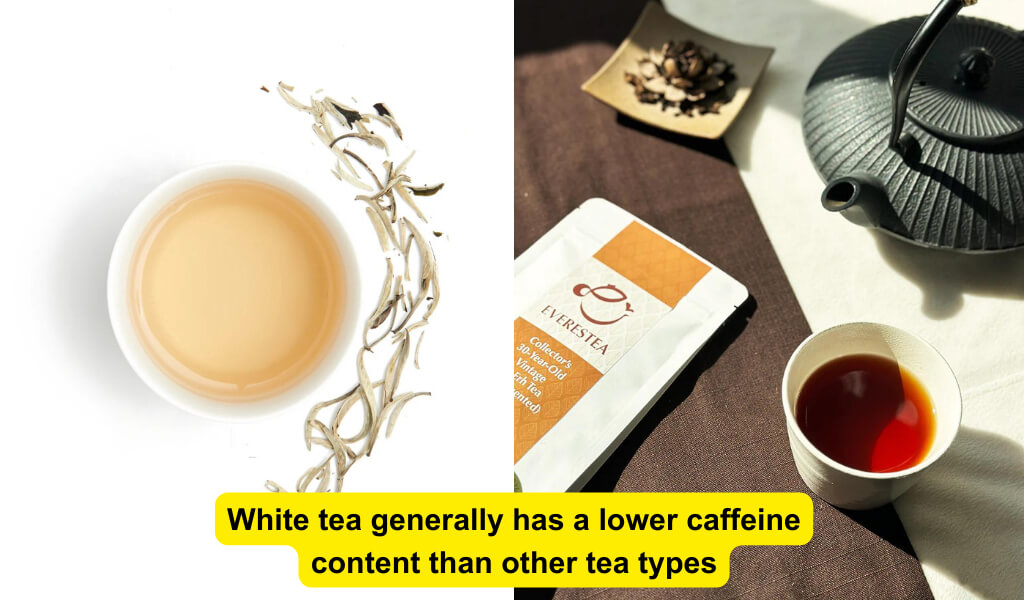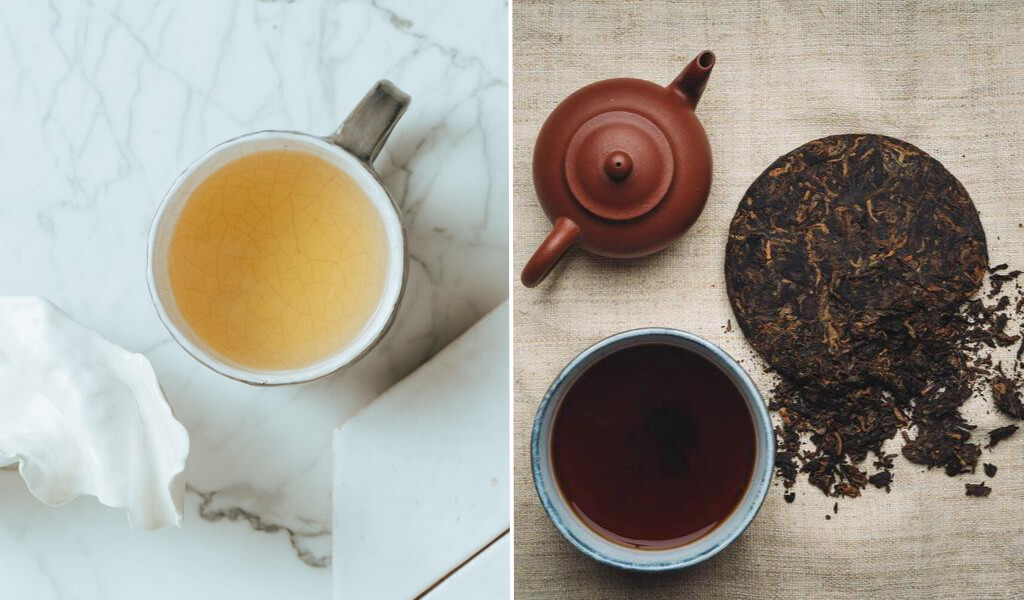If you’re anything like me, you’ll know that navigating the world of tea can be a delightful journey of discovery. “White Tea vs Pu Erh tea” is a common comparison we often come across.
I’ve compiled this comprehensive comparison to help you understand the intricacies of White Tea and Pu Erh Tea, from their origins to their production processes, health benefits, taste profiles, and so much more.
I aim to help you find a new appreciation for these remarkable teas and, perhaps, even discover your new favorite brew.
Read More:
- Oolong Tea vs White Tea: Comparison on tastes and benefits
- White Tea vs Green Tea: Ultimate comparison on distinctive features
- Black Tea vs White Tea comparison: Tastes, Nutrition and more
Quotes of tea with You
“How could I have been so blinded by a cup of tea?”
― E.V. Hewitt, Stilettos For Me, Please!
White Tea vs Pu erh tea: the basics
Allow me to introduce you to the basics of these two fascinating types of tea.
Firstly, let’s talk about Pu erh tea. Originating from China, specifically the Fujian province, Pu erh has a rich history dating back hundreds of years. This semi-oxidized tea strikes a perfect balance between the fresh qualities of green tea and the more robust flavors of black tea.
Today, Taiwan and Fujian remain the epicenters of Pu erh production, and this tea enjoys considerable popularity, particularly among connoisseurs who value its wide range of flavors and aromas.
A highlight from “The Book of Tea” confirms that Pu perh’s unique production process, involving withering under the strong sun and curling, gives it an unmatched depth of flavor.
Next up is White tea. This type of tea is predominantly produced in the Fujian province of China, and it’s known for its delicate, light flavor. Its history is intertwined with Chinese imperial culture, as it was traditionally reserved for royalty due to its rarity. White tea is the least processed tea, preserving its natural subtlety.
Its popularity has surged recently, with tea enthusiasts appreciating its subtle sweetness and soft, silky notes. As per “The Book of Tea”, White tea is harvested at a precise time, namely when young tea buds are tightly closed and covered by white hairs, hence the name.
These teas offer unique experiences, and understanding their basics is the first step in your tea discovery journey.
Difference between White Tea vs pu erh tea
| Aspect | White Tea | Pu Erh Tea |
| Production Process | Minimal, natural withering |
Involves greening, rolling, drying, and aging (raw or cooked)
|
| Taste | Becomes like Pu Erh with age |
Improves over time, gains value and desirability
|
| Collectability and Value | Increases over time | Valuable addition to collections |
| Health Benefits | High flavonoid content | Improved health benefits with age |
| Color | Pale silver to light yellow |
Raw: Vibrant amber, Cooked: Dark reddish-brown
|
| Caffeine Content | Generally lower caffeine |
Moderate caffeine content, varies with type
|
| Personal Preference | Depends on individual taste |
Versatile, caters to various preferences
|
Production Process
In terms of their production process, there are both similarities and differences.
White tea undergoes a minimal and very natural production process. Freshly picked leaves are carefully spread out and left to wither under the gentle touch of sunlight or within a well-ventilated, light-transmitting room. This ensures that the tea leaves maintain their inherent delicacy and subtleties.
Contrarily, Pu’er tea’s production is a bit more involved. Like White tea, it begins with freshly picked leaves but follows a few more steps, such as greening, rolling, and drying, before being aged naturally. A key difference here is Pu’er tea’s variation: Raw Pu’er, unfermented, and Cooked Pu’er, where the raw tea is sprinkled with water and stacked for fermentation.
White Tea vs Pu Erh Tea Taste
When considering their flavor profiles, both teas exhibit a unique charm that only gets better with time.
With age, the taste of White tea begins to mirror that of Pu’er, a factor that enhances its appeal among tea lovers. Like finely aged wine, both these teas improve with time, adding value to their taste and increasing their desirability for long-term storage.
Collectability and Value
From a collector’s perspective, both teas offer great value, and their worth only grows with time.
Their potential for long-term storage improves not only their taste but also their collectability. This quality makes White and Pu’er tea a treasured addition to any tea collection.
Pu-Erh White Tea Health Benefits
Regarding health benefits, both teas have unique offerings, with White tea standing out for its high flavonoid content.
Over time, both White and Pu’er tea undergo changes that enhance their health benefits. The charm of older tea lies not just in its mellow taste but also in its improved health value. Specifically, aged White tea tends to have a higher flavonoid content than fresh tea.
Color
True to its name, white tea exhibits a pale and delicate hue, ranging from silver to light yellow. Its soft color reflects the minimal processing it undergoes, allowing the natural essence of the tea leaves to shine through.
Pu’er tea showcases a deeper and richer color spectrum. Raw Pu’er tea tends to have a vibrant amber tone, while Cooked Pu’er tea takes on a dark reddish-brown color. These captivating hues result from Pu’er tea’s aging and fermentation processes.
Caffeine Content
White tea generally has a lower caffeine content than other tea types. However, it’s important to note that the same caffeine levels can vary depending on factors such as the specific variety of White tea and brewing methods employed. Nonetheless, for those seeking a milder caffeine experience, White tea can be a suitable choice.
Pu’er tea generally contains a moderate amount of caffeine. The exact caffeine content can be influenced by factors such as the type of Pu’er tea (raw or cooked) and the brewing technique used. It’s worth considering personal caffeine sensitivity when selecting between the two teas.
Whether you prefer a tea with a lighter caffeine kick or a bit more invigoration, Pu’er tea and White tea offer unique flavors and experiences beyond their caffeine content.
Personal Preference
Ultimately, the choice between Pu’er and White tea comes from personal preference.
The beauty of these teas lies in their versatility. They cater to various tastes, making the “best” tea that suits your taste perfectly. Whether you’re a seasoned tea connoisseur or someone starting their tea journey, the joy lies in discovering a brew that resonates with you.
Who Should Drink White Tea and Pu Erh Tea (And Why)?
White Tea Enthusiasts
Those with a penchant for subtlety and elegance might lean towards white tea. Here’s why you may choose this delicate brew:
- Light, subtly sweet flavor profile.
- Lower caffeine content than most teas.
- High in antioxidants, good for the skin.
- Promotes heart health and longevity.
- It may aid in weight management.
White tea may be your go-to brew if you’re seeking a refreshing, low-caffeine drink with many health benefits.
Pu Erh Tea Devotees
For those looking for a tea with depth and complexity, Pu Erh could be your cup of tea. Here’s why you might choose this unique type:
- The rich, earthy flavor deepens with age.
- Contains a moderate amount of caffeine.
- Aids in digestion and weight loss.
- Known for its cholesterol-lowering properties.
- Traditionally used for detoxification in Chinese medicine.
Thus, if you appreciate an aged, mature taste and are interested in its digestive and detoxifying benefits, Pu Erh tea could be a delightful choice.
Thanks for spiriteadrinks.com
FAQs
Which tea is more expensive: white tea or Pu-erh tea?
The price of both teas can vary greatly depending on factors like quality, age, and origin. However, well-aged Pu-erh teas, due to their lengthy maturation process, can often fetch higher prices.
Is Puer tea white tea?
No, Puer tea is not a white tea. Puer is a fermented tea originating from the Yunnan province in China. Unlike white tea, which undergoes minimal processing, Puer tea is fermented and aged, developing a rich, earthy flavor over time. Both teas have unique characteristics and health benefits, making them distinct within the wide spectrum of Chinese teas.
Can you drink both white tea and Pu-erh tea every day?
You can drink white tea and Pu-erh tea daily, as they offer numerous health benefits. However, due to their caffeine content, individual sensitivity may vary. As always, moderation and a balanced diet are key.
Which tea is more popular: white tea or Pu-erh tea?
Popularity can vary based on cultural contexts and personal preferences. White tea is loved for its delicate flavor and health benefits, while Pu-erh tea is cherished for its unique earthy taste and digestive benefits. Both have loyal followings in the tea-drinking world.
Which tea has a stronger flavor: white tea or Pu-erh tea?
Pu-erh tea generally has a stronger, more robust flavor than white tea. Its unique fermentation and aging process produces a deep, earthy taste, contrasting with white tea’s lighter, subtly sweet profile.
Which tea is better for evening consumption: white tea or Pu-erh tea?
Given its lower caffeine content, white tea might be a better choice for evening consumption. Pu-erh tea, while not excessively high in caffeine, still contains a moderate amount that could affect sleep for those sensitive to caffeine.
Can both white tea and Pu-erh tea be served cold?
White tea and Pu-erh tea can be served cold, also known as iced tea. This method offers a refreshing alternative, especially during warmer months, while still delivering each tea’s unique flavors and health benefits.
Which tea has more varieties: white or Pu-erh tea?
Both white and Pu-erh teas have multiple varieties. However, due to the different fermentation and aging processes Pu-erh can undergo, it may offer a wider range of flavors and characteristics, thus presenting more varieties.
I’m Shanna, creator of Spiritea Drinks. I’m all about teaching people to grow their own food, tea, cook what they harvest, and eat with the seasons.




